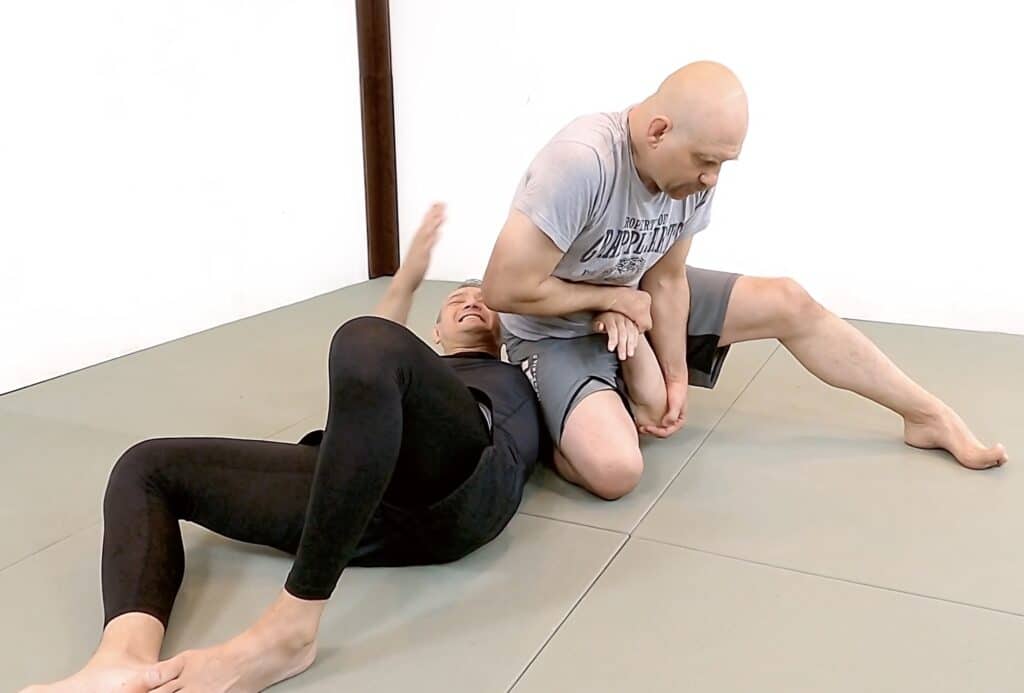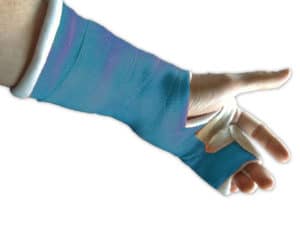Wristlocks are submissions that bend the wrist by bending, flexing, extending or rotating the hand relative to the bones of the forearm.
Some martial arts like aikido, hapkido, and traditional Japanese jujutsu specialise in wristlocks, making them a major part of their curriculum.
Most of the common BJJ jointlocks target the elbow (e.g. straight armbars), shoulder (e.g. Kimura and Americanas), knee (e.g. kneebars) and ankle (straight footlocks) and historically the wristlock has been neglected in most schools.
In fact, the wrist is probably the most under-attacked joint in all of BJJ.
In this article we’ll take a look at various aspects of wristlocks in BJJ that should give you a good primer on how, when, and where to use them and how to train them safely!
Standing Wristlocks, and Why They Don’t Work
Let’s start by talking (briefly) about Aikido wristlocks.
The Japanese martial art of Aikido places a huge emphasis on standing wristlocks; there are many variations, and they look very beautiful. Here’s a typical example of a wristlock technique known as kotegaeshi…

Aikido Kotegaeshi Wristlock
Aikido is practised with very high levels of cooperation, and true sparring against full resistance is virtually unheard. Without the feedback of attempting to execute techniques against an opponent who’s really, really trying to stop you it’s almost impossible to figure out whether a technique will really work against a non-cooperating opponent.
Fortunately there are widely practiced combat sports in which wristlocks are valid ways of winning matches, specifically IBJJF-rules Brazilian Jiu-jitsu with the gi (for adult divisions, blue belt and up) and many different no gi rule sets (IBJJF, ADCC, EBI, etc.).
When we look at these events, wristlocks from the standing position are incredibly rare. Yes, they happen once in a blue moon, but it tends to be at lower belt levels against an opponent who’s never seen that particular trick before.
Wristlocks on the ground in gi and no gi jiu-jitsu are more common. They still lag way behind the powerhouse submissions like armbars, leglocks and chokes, but I’ve seen them in action; for example, a training partner of mine once won his purple belt division with a wristlock from side control.
So why do almost all pressure-tested wristlocks occur on the ground and not the feet?
Wristlocks On the Ground and Why They Work
If I’m controlling your hand for a wristlock as in the kotegaeshi throw seen above, then I have no control over your elbow or shoulder. That means you can escape pressure on your wrist by moving your elbow and shoulder; the slack you create will buy you enough time to escape the grip on the wrist itself.
(The super-rare standing wristlocks you see are typically all SLAMMED into position using extreme speed, essentially the attacker’s strategy is to apply them so fast that the rest of the recipient’s body is immobilised by momentum and that he doesn’t have the time to take advantage of that slack.)
Successful wristlock attacks on the ground occur more often simply because it’s usually easier to immobilize the recipient’s elbow and shoulder.
There are many ways this can be accomplished…
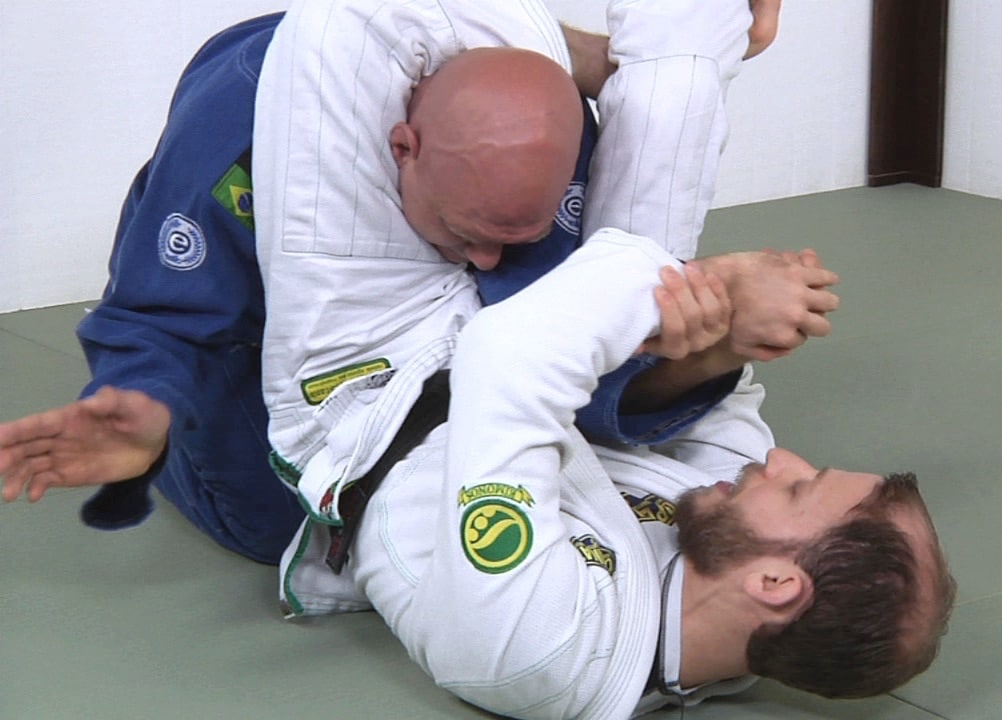
For example, you can apply a wristlock to finish a stalled triangle choke. In this case, his wrist is controlled by your hands, his elbow is jammed against your inner thigh, and his shoulder is trapped by your legs.
A powerful wristlock variation occurs in the sitting on shoulder position after a omoplata sweep. This is one of my favorites and I’ve hit it many times, which is why I included it in my omoplata instructional).
In this submission his wrist is controlled by one hand and my belly, his elbow is controlled by the other hand and the floor, and his shoulder is tightly clamped between your calf and your hamstring.
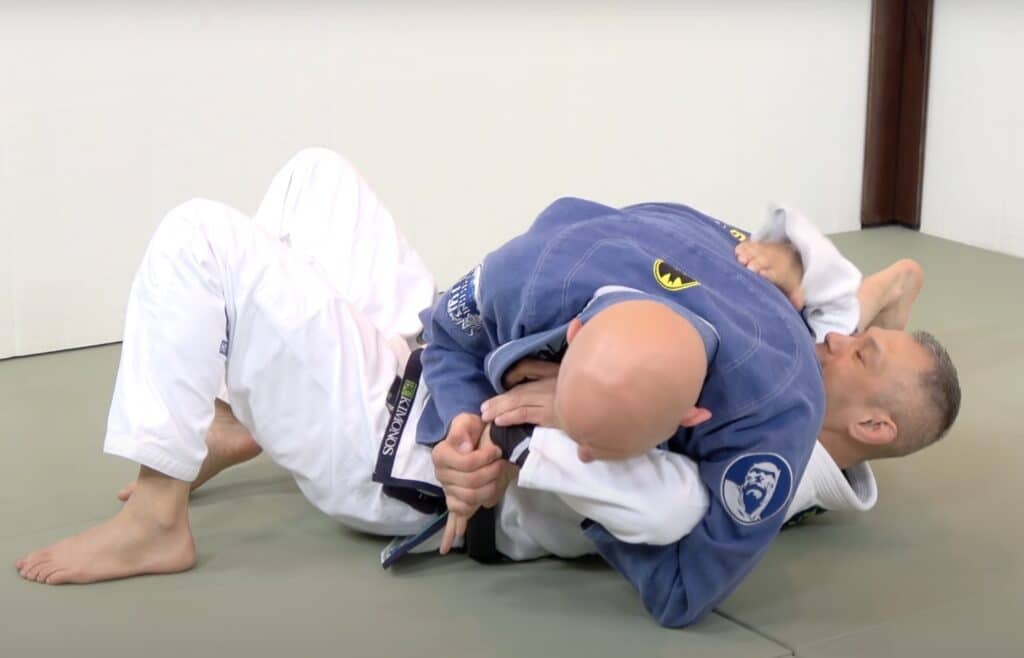
Wristlock Kimura Finish from Side Control
Finally, the wristlock finish to the Kimura from side control is one more example of a relatively high-percentage wristlock on the ground. Here his wrist is controlled my hands, his elbow is controlled by my biceps, and his shoulder is controlled by ribs.
Do you notice a trend in the 3 examples above?
Wrist, elbow, shoulder! Wrist, elbow, shoulder!! Wrist, elbow, shoulder!!!
It doesn’t really matter what combination of hands, arms, ribs, mat, legs, and head you use, but to have a high-percentage wristlock against a tough, resisting opponent, somehow all three of those joints must be controlled!
Are Wristlocks Even Legal in BJJ?
Are wristlocks legal in BJJ?
The answer is, ‘Mostly yes.’
The table on page 29 of the IBJJF rulebook clearly shows that wristlocks are illegal for kids, adolescents, and white belt adults. But for adults at blue belt level and above they are allowed.
So if you’re an adult (or planning to be) and a blue belt (or planning to be) then you should at least know a little bit about wristlocks!
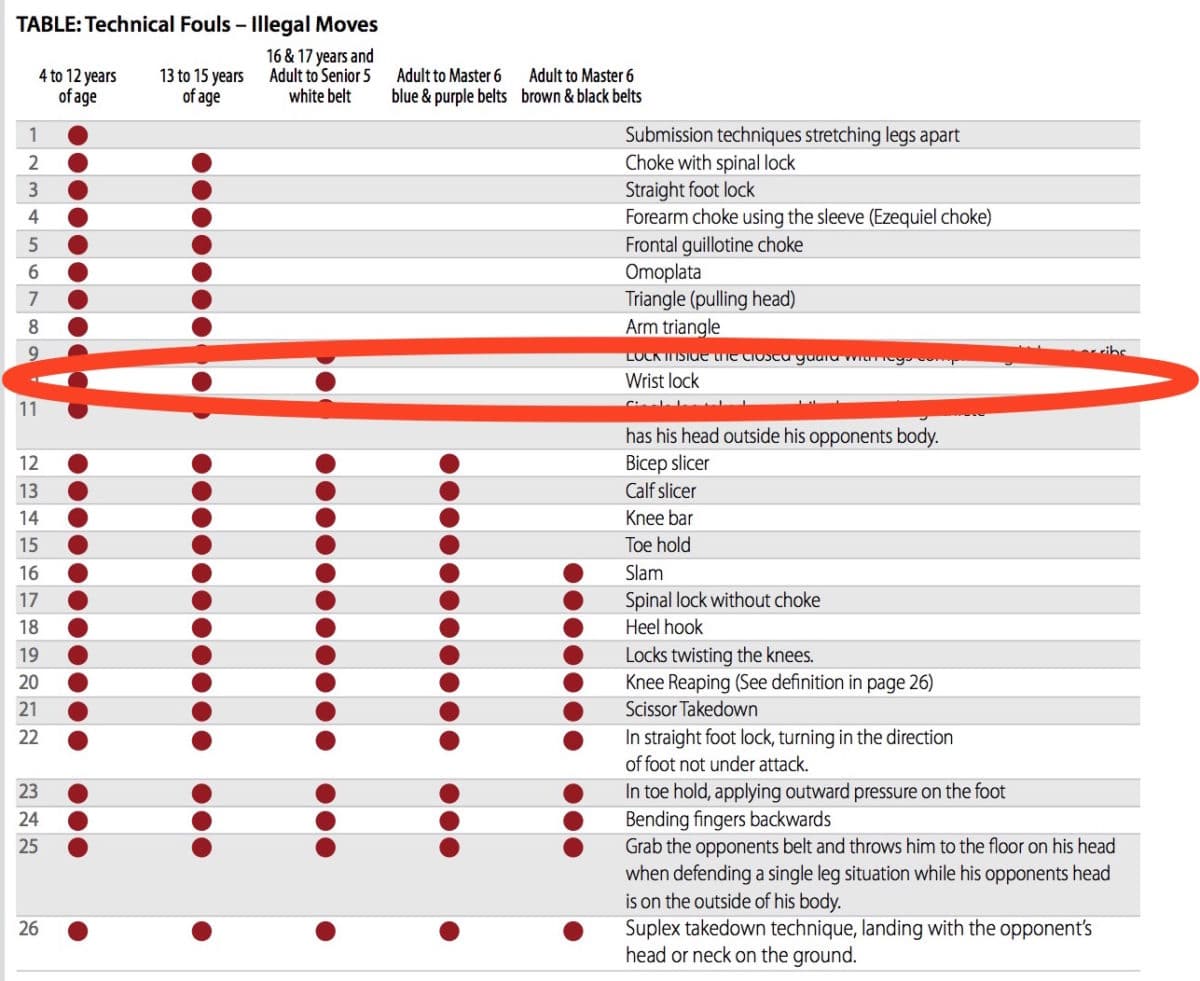
Wristlocks are legal in adult divisions, blue belt and up
Other rule systems vary wildly in whether they allow wristlocks.
For example, here’s the status of that submission according to a few other governing bodies of grappling sports…
-
- ADCC – Abu Dhabi Combat Club: Wristlocks are legal
- US Grappling: Illegal in all juvenile divisions, legal for adults
- EBI: Wristlocks are legal
- NAGA – North American Grappling Association: Illegal for kids and teens, legal for adults
- SJJIF – Sport Jiu Jitsu International Federation: Illegal for kids, legal for juveniles above white belts and adult beginners
- Judo: Wristlocks and all other small joint manipulations will result in an immediate disqualification
- Sport Sambo: Wristlocks and all other small joint manipulations are not legal
Now now matter what the official rules are, it’s important to understand that individual events (and even individual referees) may not follow all the rules and/or have their own rules.
Therefore you should always check with event organiser about the lesser-known submissions like wristlocks. You don’t want to be DQ’d for using what you think is a perfectly legal technique.
Should You Learn Wristlocks?
Absolutely yes.
Attacking someone’s wrist is just as legitimate an attack as hyperextending their arm with the straight armbar, squeezing the arteries in their neck with a lapel choke, or applying a kneebar.
And they’re just so damn handy – when someone is resisting your choke or armlock then they usually forget about their wrist. Attack the wrist and you may tap them out with that, or they’ll panic hard and give you the submission you were going for originally.
Either way, you win!
Even if you have no interest in ever actually using wristlocks to attack someone you should still practise them once in a while.
That’s because the key to preventing wristlocks is awareness about your hand and forearm being put into vulnerable situations. And the best way to develop that awareness is by learning the basics of how to apply these attacks yourself.
I would argue that if you’re an advanced white belt and can’t yet use wristlocks legally in competition then you should still start getting familiar with them.
You don’t want to be completely new to these attacks in your very first blue belt tournament, do you?
Are Wristlocks Dangerous?
I love wristlocks, but they’re undeniably dangerous. I’ve seen them cause a lot of accidental injuries.
Most aikido, hapkido and traditional ju-jutsu black belts have, at some point, sustained an injury due to one of these attacks despite the fact that most of the training in these arts is semi-cooperative.
The problem is even worse in a combat sport where people are are trying to apply and defend submissions for real. Things can get heated quickly, submissions get applied too fast, and people wait too long to tap out.
When this full-force mentality is applied to wristlocks you’e almost guaranteed an injury.
Here are four reasons why we need to be super-careful with wristlocks…
First of all the ligaments and bones of the wrist are much more delicate than those of the shoulder, knee, ankle and elbow (the commonly attacked joints in grappling), so it’s comparatively much easier to damage the wrist than those other body parts.
Secondly, serious wrist injuries take forever to heal and often get worse, not better, over time requiring surgery
Thirdly, most wristlocks come on very quickly. Apply them with speed and you’ll find that both you and your training partner will be surprised by how the lock went from zero pain to loud popping noise with no warning.
And fourthly, they’re often perceived as ‘cheesy’ submissions. This is incorrect – they’re totally legitimate. The problem is that people don’t want to tap to a submission they think is cheesy, which often means that your victim will fight a wristlock like crazy and not tap out in time.
Learn wristlocks, use them in sparring, but apply them slowly and carefully. Don’t break your toys – you can’t get better without training partners!
Some BJJ Wristlocks to Get You Started…
In this first video I take you through 5 wristlocks that I actually apply on a fairly regular basis in BJJ sparring. Watch it and you’ll see some examples of high percentage applications of this submission in action…
This next video features my friend Jeff Mezaros sharing a very sneaky (and effective) wristlock from the closed guard…
This next video is getting advanced. In it I show how to use sankyo – a classic Aikido wristlock – to submit an opponent who’s on your back in rear mount.
It’s a fantastic way to go from one of the worst positions in BJJ to winning the match!
How to Train BJJ with an Injured Wrist
I hope you’ve paid attention to the reasons I gave earlier why wristlocks can be so dangerous. And I hope that if you’re caught in one of them then you’ll tap out early and tap out often…
But on the off chance that you don’t tap in time and your wrist gets injured, well, here’s a drill you can do during the long and painful recovery!
Good luck with your training. Stay safe and don’t hurt your training partners!
Stephan Kesting
More BJJ Resources
If you’d like some more help developing your gi and no gi games then here are a couple of other resources for you…
THE GRAPPLEARTS BJJ MASTER APP
This BJJ app by black belt Stephan Kesting contains 457 minutes of free-world class instruction.
It contains techniques and strategies for every aspect of Brazilian jiu-jitsu including chokes, joint locks, guard sweeps, takedowns, pin escapes, guard passing, and more.
This is your pocket reference to learn BJJ as fast as possible.
Click here for more info and to download The Grapplearts BJJ Master App for free.
THE MODERN LEGLOCK FORMULA WITH ROB BIERNACKI AND STEPHAN KESTING
After years of research and development The Modern Leglock Formula with Rob Biernacki and Stephan Kesting is out!
This ultimate guide to leglocking in the modern era by these two well-known BJJ black belts instructors is available both as a 6 DVD set, and also in an online format that you can access instantly on your computer, phone, or tablet.
This resource will give you a proven,step-by-step system for safely adding ultra-effective lower body submissions to your game. Now you can add the same leglock techniques and strategies that have transformed the grappling scene to your own submission arsenal.
Click here for more information about The Modern Leglock Formula.
OMOPLATA 2.0, YOUR GUIDE TO THE MOST VERSATILE SUBMISSION IN JIU-JITSU
After 2 decades of research, experimentation and development, the Omoplata 2.0 instructional is now available!
This is the ultimate guide to the omoplata, and it’s available in online format, a DVD set, and in app format as well.
You’ll get a complete step-by-step system for the omoplata, not just a bunch of random techniques.
You’ll learn entries into the omoplata from every position, how to finish bigger and stronger people with it, how to seamlessly transition into sweeps and other submissions, and exactly how to completely shut down all of your opponent’s omoplata escapes and counters.
Click here for more information about Omoplata 2.o
The post Wristlocks in BJJ; What Makes Them Work? appeared first on Grapplearts.

